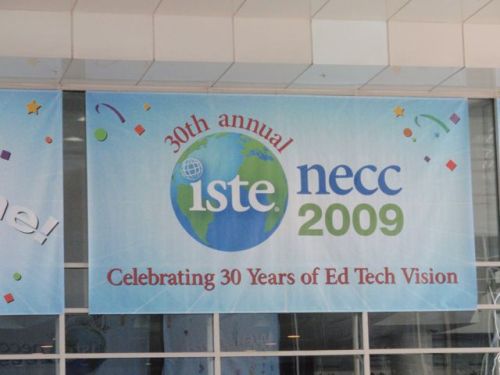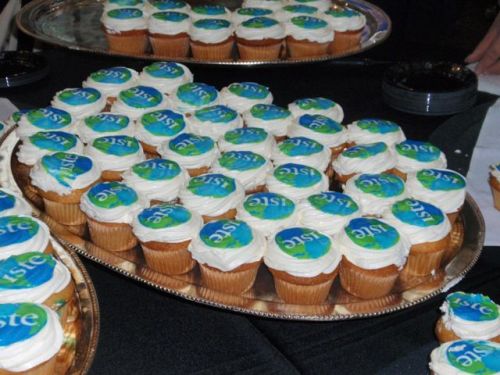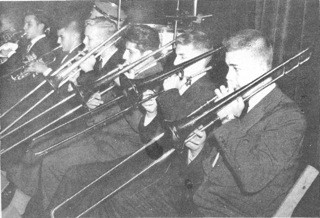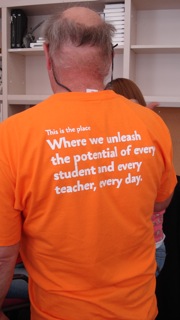One of my favorite Sunday morning rituals is reading the NY Times cover to cover, sitting on my sun porch and balancing a mug of coffee on my lap. Last Sunday I read the Times on a plane from Logan to Reagan International Airport, in Washington DC. I was there for four days attending the 30th annual National Educational Computing Conference, sponsored by the International Society for Technology in Education.

Over the last decade, the library profession has been transformed by technology. While the core principals haven’t changed isince the early part of the 20th century, when they were formulated by the Indian Mathematician and Librarian S.R. Ranganathan, the ways in which librarians select, arrange, deliver, and instruct about our resources are vastly different today. Making it pretty hard, and very important, to keep up with technology tools that are currently influencing teaching and learning, and finding out about those that are on the horizon. When I am at the Academy, I feel pretty confident in my status as a technology evangelist. I am an early adopter, and eager user of available technology tools. I am on the Academic Committee on Technology and teach teachers about technology tools and their uses in enhancing teaching and learning. Nevertheless, whenever I attend conferences like NECC and Computers in Libraries, I am blown away by the things that teachers and librarians are doing on the cutting edge. It is humbling, but also tremendously energizing.
Before the conference actually began, I attended a half-day workshop on Fair Use. Having just spent my sabbatical studying Copyright, including taking seven online courses offered by the Center of Intellectual Property at the University of Maryland, the content was not new or surprising to me. However, the presenters did an excellent job of pulling together materials (freely available on Wikispaces at Copyright Confusion) and in presenting them in such an engaging manner that the three hours (no break!) flew by. The session featured Renee Hobbs, Temple University, Media Education Lab with Kristin Hokanson, Michael RobbGrieco and Joyce Valenza.

Joyce and I went to Japan together in 1998 as part of the Fulbright Teachers Program, and it was good to catch up with her. The bottom line of the workshop is that fair use rights are extensive, and entirely consistent with the purpose of copyright. We as educators need to understand and use these rights, and model appropriate fair use for our students. To the extent that Librarians adopt a “gatekeeper” role, we shoot ourselves in the foot.
After the workshop, the conference got off to a fast start with the Opening Keynote by Malcolm Gladwell, whose best-selling books about contemporary social phenomena are very popular in the library. Gladwell’s newest work is Outliers.
Because it is NECC’s 30th anniversary, we were treated to an opening gala featuring champagne and cupcakes!

The conference mirrored life in the information age, with plenty of technological overload. There were keynote addresses, dozens of concurrent presentations, BYOL (bring your own laptop) instructional sessions, poster sessions, demonstration classrooms, ISTE division meetings, and dedicated “playgrounds.” I volunteered in the 21st Century Media Center Playground, where participants could learn about Web 2.0 tools from wikis to Second Life.

The attendees were extremely engaged in learning from and with the expert presenters.

And all of that content was only the tip of the iceberg. The vendors turned out in full force, offering displays, mini lessons, and unlimited technical support. It was both exhilerating and exhausting. By the time I boarded the shuttle bus route for my hotel each day, I had put in twelve hours of work/learning. I was on the pink route, naturally.
 The conference was held at the DC Convention center. It a huge venue, on three levels, on both sides of 11th street. It took me a couple of days to learn my way around. The center sported some unconventional sculpture. This bicycle wreath, suspended in a stairwell, was my favorite.
The conference was held at the DC Convention center. It a huge venue, on three levels, on both sides of 11th street. It took me a couple of days to learn my way around. The center sported some unconventional sculpture. This bicycle wreath, suspended in a stairwell, was my favorite.

I ventured outside of the convention center one evening to attend a client reception and tour of the new Blackboard coprporate offices.
 The Bb offices were beautiful, but couldn’t compare to the understated majesty of the Library of Congress.
The Bb offices were beautiful, but couldn’t compare to the understated majesty of the Library of Congress.
 LC sponsored an evening reception for attendees. It was an incredible privilege to be allowed inside areas that are usually off-limits to the public.
LC sponsored an evening reception for attendees. It was an incredible privilege to be allowed inside areas that are usually off-limits to the public.



 In response to an inquiry from an Andover alumnus who was part of the Academy’s Jazz Band “The Aces” during the 1950’s, the girls found and scanned pictures of the band.
In response to an inquiry from an Andover alumnus who was part of the Academy’s Jazz Band “The Aces” during the 1950’s, the girls found and scanned pictures of the band.

 Many of these old houses still exist around campus. It would be fun to do a scavenger hunt to see how many could be identified. Cassie and Ashley enthusiastically agreed that it is great to have a summer job where you can learn interesting things while you are working. The entire staff of the OWHL is in complete agreement.
Many of these old houses still exist around campus. It would be fun to do a scavenger hunt to see how many could be identified. Cassie and Ashley enthusiastically agreed that it is great to have a summer job where you can learn interesting things while you are working. The entire staff of the OWHL is in complete agreement.
 I have again followed the instructions and appealed my suspension, but haven’t heard back from the Twitter police. If you know me, you know that I am a dedicated rule-follower. I was a girl scout and girl scout leader! I am a librarian! If you have a Twitter account, please tweet them on my behalf (@Twitter) Please help free my account!
I have again followed the instructions and appealed my suspension, but haven’t heard back from the Twitter police. If you know me, you know that I am a dedicated rule-follower. I was a girl scout and girl scout leader! I am a librarian! If you have a Twitter account, please tweet them on my behalf (@Twitter) Please help free my account!

 The booths were attractive, imaginative, and, most importantly, informative. Many vendors provided scheduled presentations on their products, and all of the exhibits were manned with helpful representatives of the sponsor. Elvis was there.
The booths were attractive, imaginative, and, most importantly, informative. Many vendors provided scheduled presentations on their products, and all of the exhibits were manned with helpful representatives of the sponsor. Elvis was there. As was this friendly Bee.
As was this friendly Bee. And the President and First Lady.
And the President and First Lady.





 The conference was held at the DC Convention center. It a huge venue, on three levels, on both sides of 11th street. It took me a couple of days to learn my way around. The center sported some unconventional sculpture. This bicycle wreath, suspended in a stairwell, was my favorite.
The conference was held at the DC Convention center. It a huge venue, on three levels, on both sides of 11th street. It took me a couple of days to learn my way around. The center sported some unconventional sculpture. This bicycle wreath, suspended in a stairwell, was my favorite.
 The Bb offices were beautiful, but couldn’t compare to the understated majesty of the Library of Congress.
The Bb offices were beautiful, but couldn’t compare to the understated majesty of the Library of Congress.